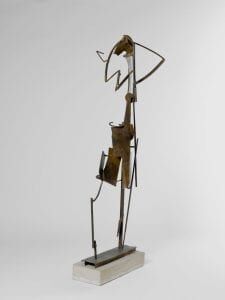FEMME SE COIFFANT I – WOMAN COMBING HER HAIR I
1931
Medium : Iron, cast, welded
Dimensions : 168,5 x 54 x 27 cm
Women à leur toilette: a constant theme in González’s work
This sculpture is inspired by the figure of a woman brushing her hair. She is standing up and dressed in a nightgown or nightshirt. She supports her weight with her left leg, which is straight, while advancing her right leg, which is slightly bent at the knee. She raises both arms and joins her hands behind her head to hold her hair.
Julio González treats the theme of women grooming themselves or combing their hair (à leur toilette) very often over the course of his creative life. He studies the gesture of a woman brushing her hair for the first time in a group of rapidly executed ink and brush sketches, made in 1904. The same gesture appears on other occasions, above all in a group of drawings and pastels produced between 1909 and 1911, which are clearly inspired by Degas. Like the great Impressionist master, what interests González in this group is to capture the singularity of the gesture and its hidden linear fluidity. The same plastic pursuits inspire both series of drawings executed in 1927 and 1928, the first with a seated model, the second with a standing model.
The dematerialization of volumes and the integration of empty space: a revolution in 20th c. sculpture
The sculpture analyzed here was preceded by another series of drawings of which fifteen have been conserved. Its point of departure is a drawing belonging to the Museo Nacional Centro de Arte Reina Sofia (MNCARS) in Madrid (ill. 1). It is called Femme s’habillant (Woman getting dressed), but the position of the body and the gesture of the arms indicate that its focus is combing the hair. The drawing reflects a naturalistic perception of the female figure, subsequently submitted to an intense process of geometric simplification. The light illuminates the woman, posed in a three-quarters position, and the zones of light and shade are differentiated by red, brown and green colored pencils, outlined by lines in ink and pen, which accentuates its flatness and allows the viewer to understand that it represents cut and assembled metallic planes. The best lit zones are converted into empty space, like we see with the woman’s left leg, drawn only with one profile line. In later drawings, González amplifies progressively the empty planes, above all in the upper part of the figure, reinforcing the lightness of the ensemble. A drawing entitled Étude pour Femme se coiffant (Study for woman combing her hair) belonging to the IVAM Centre Julio González (ill. 2) allows us to see once more, traced in pencil, the natural profile of the woman’s body, while on the inside we see a structure of cut planes and lines, elaborated with colored pencils, pen and ink. The configuration is very similar to the assembly of planes and iron rods that constitute the sculpture.
The dematerialization of volumes and the integration of empty space, delineated by lines, like we see here in Femme se coiffant I, constitutes González’s great stylistic discovery in the 1930s. All iron sculpture of the 20th century will subsequently be indebted to this discovery.
Preparatory drawings(ill. 1 & 2), Femme se coiffant I, 1931, MNAM Centre Pompidou Paris









